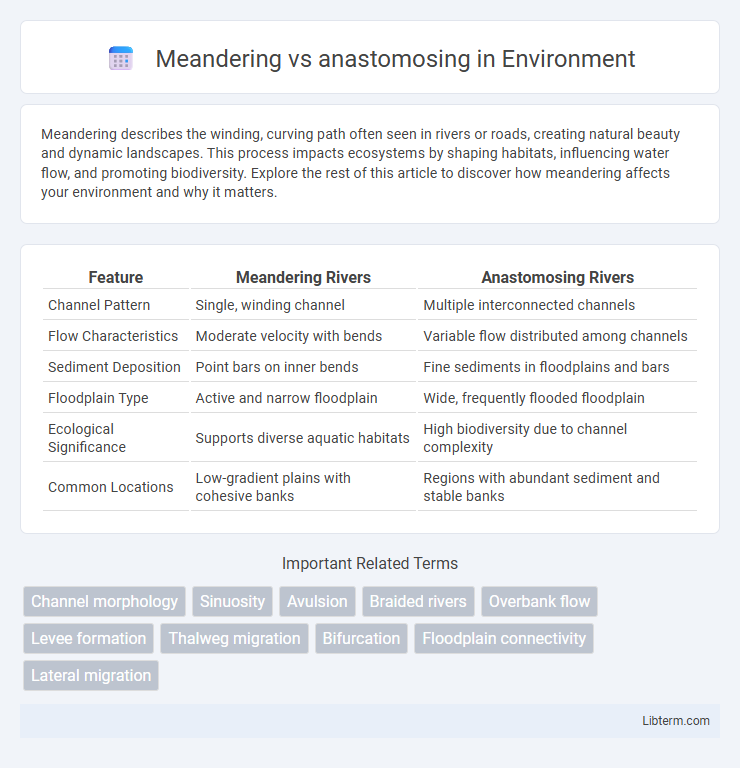Meandering describes the winding, curving path often seen in rivers or roads, creating natural beauty and dynamic landscapes. This process impacts ecosystems by shaping habitats, influencing water flow, and promoting biodiversity. Explore the rest of this article to discover how meandering affects your environment and why it matters.
Table of Comparison
| Feature | Meandering Rivers | Anastomosing Rivers |
|---|---|---|
| Channel Pattern | Single, winding channel | Multiple interconnected channels |
| Flow Characteristics | Moderate velocity with bends | Variable flow distributed among channels |
| Sediment Deposition | Point bars on inner bends | Fine sediments in floodplains and bars |
| Floodplain Type | Active and narrow floodplain | Wide, frequently flooded floodplain |
| Ecological Significance | Supports diverse aquatic habitats | High biodiversity due to channel complexity |
| Common Locations | Low-gradient plains with cohesive banks | Regions with abundant sediment and stable banks |
Introduction to Fluvial Channel Patterns
Meandering rivers exhibit a single, sinuous channel with continuous bends characterized by sediment deposition on point bars and erosion on outer banks, influencing floodplain development and habitat diversity. Anastomosing channels consist of multiple interconnected, stable channels separated by vegetated islands, promoting complex flow patterns and enhanced sediment retention. Understanding these fluvial channel patterns aids in interpreting river dynamics, sediment transport, and ecological functions in alluvial environments.
Defining Meandering Rivers
Meandering rivers are characterized by a single, sinuous channel with smooth, sweeping bends that develop due to sediment deposition and erosion along the banks. These rivers exhibit distinct point bars on the inside of bends and cut banks on the outer edges, creating a dynamic equilibrium in channel shape and flow velocity. Unlike anastomosing rivers, which consist of multiple interconnected channels separated by stable vegetated islands, meandering rivers maintain a single continuous path that migrates laterally over time.
Key Features of Anastomosing Rivers
Anastomosing rivers feature multiple interconnected channels separated by stable, often vegetated islands, forming a complex network distinct from the single winding channel of meandering rivers. These rivers typically have lower gradient slopes, higher sediment loads, and floodplains prone to frequent overbank flooding, which supports diverse riparian ecosystems. Their key characteristics include channel stability, high lateral connectivity, and sediment deposition that enhances habitat diversity and floodwater storage capacity.
Geomorphological Differences
Meandering rivers feature single, sinuous channels with pronounced lateral migration, forming point bars and cut banks that shape floodplains through erosion and deposition. Anastomosing rivers comprise multiple interconnected channels separated by stable, vegetated islands, often occurring in low-gradient environments with cohesive bank materials that limit lateral migration. These geomorphological differences result in distinct floodplain architectures, sediment dynamics, and ecological habitats characteristic of each river type.
Sediment Deposition Processes
Meandering rivers exhibit sediment deposition primarily along point bars on the inner bends, promoting lateral channel migration through erosion and deposition cycles. Anastomosing rivers consist of multiple interconnected channels separated by stable, vegetated islands, where fine sediments accumulate in low-energy interchannel areas, enhancing vertical aggradation and floodplain stability. The contrasting sediment dynamics in meandering and anastomosing systems control distinct floodplain architectures and influence habitat diversity.
Hydrological Dynamics Compared
Meandering rivers exhibit single, sinuous channels characterized by lateral erosion and point bar deposition, resulting in localized flow velocity variations and well-defined floodplains. Anastomosing rivers consist of multiple interconnected channels separated by stable, vegetated islands, promoting complex flow patterns with diverse hydraulic connectivity and sediment transport pathways. Hydrological dynamics in anastomosing systems tend to support higher flood attenuation and enhanced groundwater recharge compared to the more predictable, channelized flow regime of meandering rivers.
Ecological Impacts and Biodiversity
Meandering rivers create diverse habitats through point bars and oxbow lakes, supporting specialized aquatic and riparian species that thrive in dynamic flow conditions. Anastomosing rivers, characterized by multiple stable channels separated by floodplain wetlands, enhance habitat complexity and connectivity, promoting higher biodiversity by providing refuge during floods. The ecological impacts of anastomosing systems often include increased nutrient retention and sediment deposition, which support richer plant communities and diverse wildlife assemblages compared to single-thread meandering streams.
Influencing Factors and Formation
Meandering rivers typically form in environments with moderate gradients and a cohesive but erodible bank material, where flow velocity variations cause lateral erosion and deposition, leading to sinuous, single-thread channels. Anastomosing rivers develop under low-gradient conditions with abundant sediment supply and cohesive floodplain vegetation, promoting multiple stable channels separated by persistent floodplain islands. Influencing factors such as sediment load, bank material cohesion, flow regime, and valley morphology critically determine whether a river adopts a meandering or anastomosing planform during its natural evolution.
Human Interactions and Management
Meandering rivers, characterized by single, sinuous channels, are more easily managed for flood control and navigation, while anastomosing rivers with multiple interconnected channels present complex challenges due to sediment deposition and habitat diversity. Human interactions with meandering systems often involve riverbank stabilization and channelization to prevent erosion, whereas anastomosing rivers require adaptive management that balances ecological preservation with flood mitigation. Effective management practices incorporate hydrological monitoring, sediment management, and restoration strategies to maintain ecosystem services and reduce the impact of human activities on both river types.
Summary: Meandering vs Anastomosing Rivers
Meandering rivers feature a single, sinuous channel with distinct outer bends and inner point bars, formed primarily by lateral erosion and deposition. Anastomosing rivers consist of multiple interconnected channels separated by stable, vegetated islands, typically occurring in low-gradient, fine sediment environments. The key difference lies in channel cohesion and stability, with anastomosing systems exhibiting more complex, stable multi-channel networks compared to the dynamic single-channel nature of meandering rivers.
Meandering Infographic

 libterm.com
libterm.com